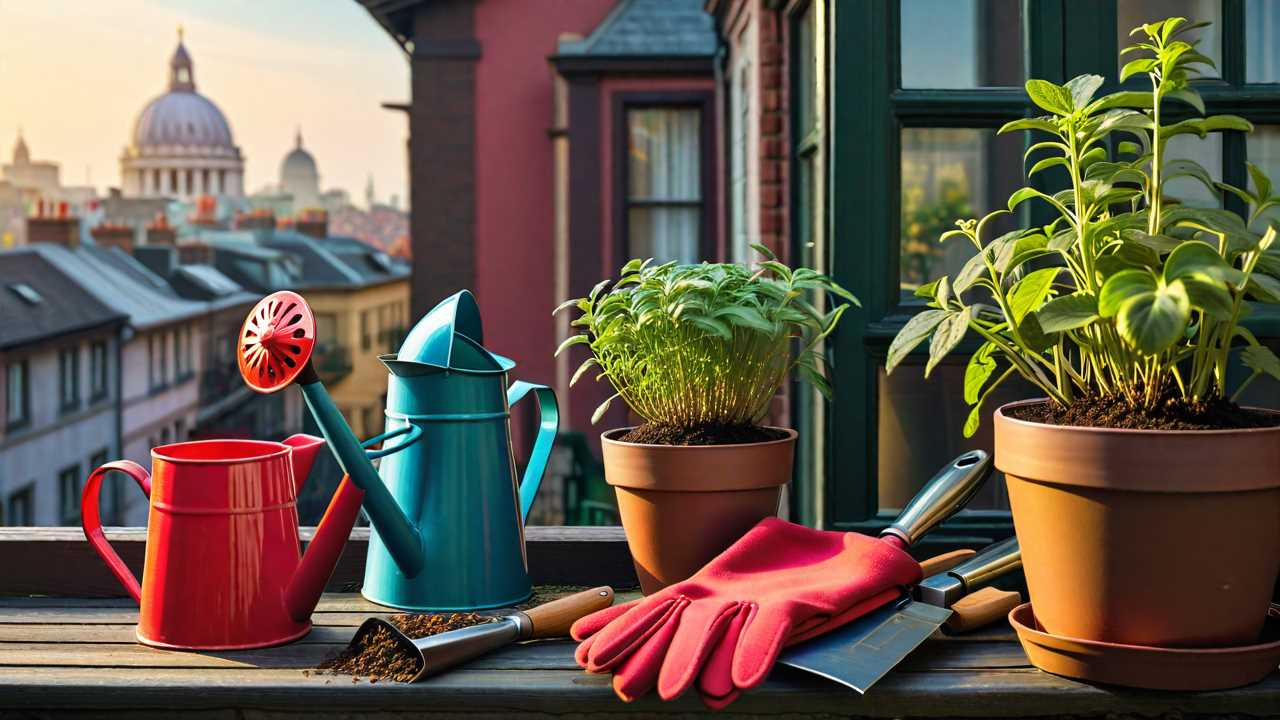
To excel in urban gardening, it's crucial to equip yourself with the right tools that cater to the unique challenges of city living. From compact hand tools tailored for tight spaces to innovative watering solutions designed for efficiency, having the correct gear can make all the difference in your urban garden's success. But what specific tools should you focus on to guarantee your plants thrive in an urban environment? Let's investigate the essential tools that will set you up for gardening triumph amidst the cityscape.
To begin your urban gardening journey, you'll need a few essential hand tools that will make your gardening tasks more manageable and efficient.
A sturdy trowel is indispensable for planting, transplanting, and weeding. Look for one with a comfortable handle and a strong, durable blade.
A hand pruner is essential for trimming and shaping your plants. Opt for a bypass pruner for clean cuts on green stems and branches or an anvil pruner for dead wood.
A quality pair of gardening gloves will protect your hands from thorns, sharp edges, and dirt while providing grip and dexterity.
Additionally, a handheld rake or cultivator is perfect for breaking up soil, removing weeds, and aerating the ground.
Finally, a watering can with a fine rose attachment ensures gentle and precise watering for your delicate plants.
These essential hand tools will set you on the right path for a successful urban gardening experience.
Space-Saving Planters
Looking to maximize your gardening space in urban settings? Space-saving planters are a fantastic solution for growing a variety of plants in a limited area. Hanging planters, vertical planters, and stackable planters are excellent options that can help you optimize your available space.
Hanging planters are perfect for trailing plants like ivy or herbs. By suspending them from a balcony railing or ceiling, you can add greenery without taking up precious floor space.
Vertical planters, such as wall-mounted pockets or trellises, allow you to create a vibrant living wall, ideal for small spaces or even indoor gardening.
Stackable planters are another great choice, especially for growing different types of plants in a compact area. These tiered planters enable you to grow a variety of herbs, flowers, or vegetables without needing a large garden plot. They're versatile and can be easily moved around to catch the sun or maximize space efficiency.
Consider incorporating these space-saving planters into your urban garden to improve both the aesthetic appeal and productivity of your green space.
Efficient Watering Systems
Maximize the efficiency of your urban garden by implementing efficient watering systems that cater to the specific needs of your plants. Watering your plants effectively is essential for their growth and health, especially in urban settings where space might be limited.
Here are some efficient watering systems to explore:
- Drip Irrigation: This system delivers water directly to the roots of your plants, minimizing water wastage through evaporation or runoff. It's ideal for urban gardens as it can be customized to fit different plant types and sizes.
- Self-Watering Planters: These planters have a reservoir that stores water, allowing the plants to absorb moisture as needed. They're perfect for busy gardeners or those in urban areas with erratic watering schedules.
- Rain Barrels: Harvesting rainwater in barrels is an eco-friendly way to water your urban garden. You can connect a hose to the barrel and use the collected rainwater to irrigate your plants, reducing your water bills and environmental impact.
Protective Gear
Consider integrating the necessary protective gear into your urban gardening routine to safeguard yourself from potential hazards and guarantee a safe gardening experience. When working in your garden, it's essential to prioritize your safety.
Start with a sturdy pair of gardening gloves to protect your hands from cuts, scrapes, and thorns. Opt for gloves that fit well and offer good grip for handling tools and plants.
Additionally, wearing safety goggles can shield your eyes from debris, harmful chemicals, or branches while pruning. A durable pair of closed-toe shoes or boots is also vital to protect your feet from sharp objects or potential insect bites.
If you're working with power tools or handling pesticides, consider wearing a respirator mask to prevent inhaling harmful fumes or particles.
Lastly, don't forget to apply sunscreen to exposed skin to prevent sunburn during long hours in the garden.
Frequently Asked Questions
Can I Use Regular Soil for Urban Gardening?
You can't just grab any dirt for urban gardening; it's like expecting a fish to thrive in a desert. Regular soil lacks nutrients and drainage essential for urban plants. Opt for quality potting mix for success.
How Often Should I Fertilize My Plants in a Small Space?
In a small space, fertilize your plants every 2-4 weeks during the growing season. Adjust based on plant type and specific needs. Consider using a balanced fertilizer to guarantee proper nutrition for healthy growth.
Are Vertical Planters Suitable for All Types of Plants?
Vertical planters are versatile but may not suit all plants. Consider plant size and root structure. Herbs, succulents, and small vegetables thrive in vertical setups. Taller plants or those with deep roots may need traditional pots.
What Is the Best Way to Prevent Pests in Urban Gardens?
To keep pests at bay in your urban garden, remember the saying: "An ounce of prevention is worth a pound of cure." Regularly inspect plants, use natural repellents like neem oil, and practice good garden hygiene.
Can I Use Rainwater for Watering My Urban Garden?
You can definitely use rainwater for watering your urban garden. It's a great eco-friendly option that provides natural nutrients. Just make sure to collect it in clean containers and avoid using water from roofs treated with harmful chemicals.
 SportsHollywoodLifestyleFashionHome & GardenTrendsPrivacy PolicyTerms And Conditions
SportsHollywoodLifestyleFashionHome & GardenTrendsPrivacy PolicyTerms And Conditions
